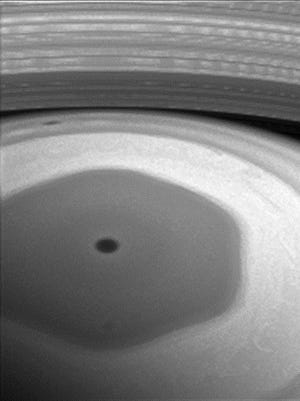Saturn's hexagon-shaped storm stuns in new close-up images

NASA's Cassini spacecraft sent back more jaw-dropping photos of Saturn this week.
The images, taken Saturday and Sunday, show scenes from high above Saturn’s northern hemisphere, including one of the planet’s strange hexagon-shaped storm. Each side of the hexagon is about as wide as Earth. A circular storm lies at the center, at the planet's north pole.
The hexagon is actually a current of air in Saturn's upper atmosphere, similar to Earth's jet streams, according to meteorologist Eric Berger of ARS Technica. It has winds estimated at 200 mph.
"Scientists don't know how long the feature has existed, but they think because there are no landforms—such as mountains on Earth — to disrupt the weather pattern it may persist for a long time," Berger said.
These are the first photos from the new "ring-grazing orbits" phase of the Cassini mission, which began on Nov. 30. Each of the week-long orbits — 20 in all — carries the spacecraft high above Saturn's northern hemisphere before sending it skimming past the outer edges of the planet's main rings, NASA said.

"It's taken years of planning, but now that we're finally here, the whole Cassini team is excited to begin studying the data that come from these ring-grazing orbits," said Linda Spilker, Cassini project scientist at NASA's Jet Propulsion Laboratory, in a statement. "This is a remarkable time in what's already been a thrilling journey."
More images of the planet, its rings and its moons will be coming in the weeks and months ahead.
The images released this week were taken by a wide-angle camera at a distance of about 240,000 miles from Saturn.
The Cassini mission will continue through Sept. 15, 2017, at which point the spacecraft will take a final dive into Saturn's atmosphere and burn up.
Launched in 1997, Cassini has been studying Saturn and its moons since 2004. The Cassini mission is a cooperative project of NASA, ESA (the European Space Agency) and the Italian Space Agency.
